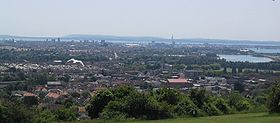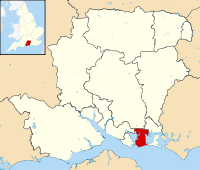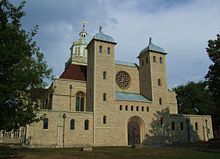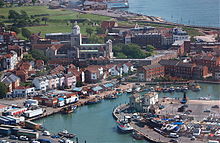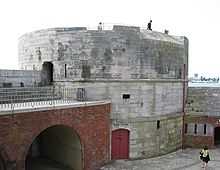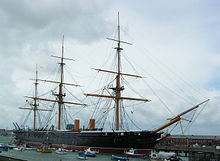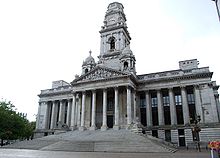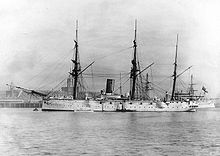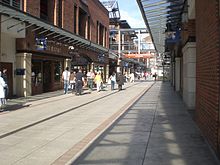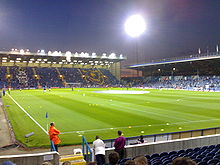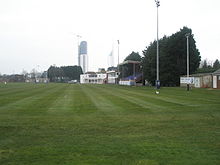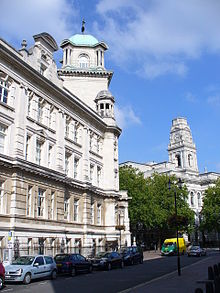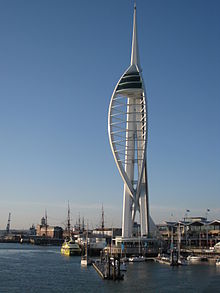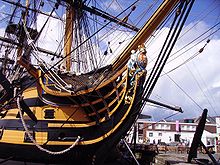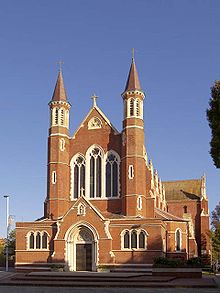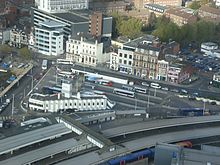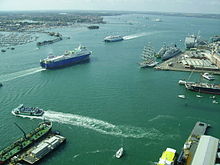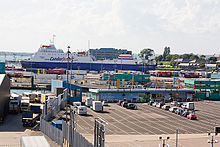
Portsmouth
Did you know...
SOS Children, which runs nearly 200 sos schools in the developing world, organised this selection. Before you decide about sponsoring a child, why not learn about different sponsorship charities first?
| Portsmouth | |||
|---|---|---|---|
| — City and Unitary Authority Area — | |||
| City of Portsmouth | |||
| Portsmouth Skyline viewed from Portsdown Hill | |||
|
|||
| Nickname(s): Pompey | |||
| Motto: Heaven's Light Our Guide | |||
| Location within Hampshire | |||
| Sovereign state | United Kingdom | ||
| Constituent country | England | ||
| Region | South East England | ||
| Ceremonial county | Hampshire | ||
| Admin HQ | Portsmouth City Centre | ||
| Government | |||
| • Type | Unitary authority, City | ||
| • Governing body | Portsmouth City Council | ||
| • Leadership | Leader & Cabinet | ||
| Area | |||
| • City and Unitary Authority Area | 15.54 sq mi (40.25 km2) | ||
| Population (2011 est.) | |||
| • City and Unitary Authority Area | 205,400 ( Ranked 76th) | ||
| • Urban | 442,252 | ||
| • Metro | 1,547,000 | ||
| • Ethnicity (United Kingdom Census 2006 Estimate) |
91.4% White 3.6% S.Asian 1.2% Black 1.3% Mixed 2.5% Chinese and other |
||
| Time zone | GMT ( UTC0) | ||
| • Summer ( DST) | BST ( UTC+1) | ||
| Website | Portsmouth City Council | ||
Portsmouth ( / ˈ p ɔː t s m ə θ /) is the second largest city in the ceremonial county of Hampshire on the south coast of England. Portsmouth is notable for being the United Kingdom's only island city; it is located mainly on Portsea Island. It is situated 64 miles (103 km) south west from London and 19 miles (31 km) south east of Southampton.
As a significant naval port for centuries, Portsmouth is home to the world's oldest dry dock still in use and also home to some famous ships, including HMS Warrior, the Tudor carrack Mary Rose and Lord Nelson's flagship, HMS Victory. Although smaller than in its heyday, the naval base remains a major dockyard and base for the Royal Navy and Royal Marine Commandos whose Headquarters resides there. There is also a thriving commercial ferryport serving destinations on the continent for freight and passenger traffic. The City of Portsmouth and Portsmouth Football Club are both nicknamed Pompey.
The Spinnaker Tower is a striking recent addition to the city's skyline. It can be found in the redeveloped former HMS Vernon, formerly a shore establishment or ' stone frigate' of the Royal Navy, now an area of retail outlets, restaurants, clubs and bars now known as Gunwharf Quays.
The City of Portsmouth has a population of 207,100 and is the only city in England with a greater population density (5,145 /km2 (13,330 /sq mi)) than London (4,984 /km2 (12,910 /sq mi)). The Portsmouth Urban Area, which includes Fareham, Portchester, Gosport and Havant, is the 13th largest urban area in the United Kingdom and the largest in Hampshire, with an estimated 520,000 residents Office of Population Censuses and Surveys Census 2011. Portsmouth combines with Southampton to form a single metropolitan area with a population over a million, one of the United Kingdom's most populous metropolitan areas.
History
There have been settlements in the area since before Roman times, mostly being offshoots of Portchester, which was a Roman base ( Portus Adurni) and possible home port of the Classis Britannica. Winston Churchill stated in his book "A History of the English Speaking Peoples Volume One The Birth of Britain" (page 65) that Portsmouth was founded in 501 by Port, the pirate. Others say that Portsmouth is commonly regarded as having been founded in 1180 by the Anglo-Norman lord Jean de Gisors. Most early records of Portsmouth are thought to have been destroyed by Norman invaders following the Norman Conquest. The earliest detailed references to Portsmouth can be found in the Southwick Cartularies. However, there are records of "Portesmūða" from the late 9th century, meaning "mouth of the Portus harbour". The Anglo-Saxon Chronicle entry for 501 claims that "Portesmuða" was founded by a Saxon warrior called Port, though historians do not accept that origin of the name. The Chronicle states that:
- Her cwom Port on Bretene ⁊ his .ii. suna Bieda ⁊ Mægla mid .ii. scipum on þære stowe þe is gecueden Portesmuþa ⁊ ofslogon anne giongne brettiscmonnan, swiþe æþelne monnan. (Here Port and his 2 sons Bieda and Mægla came to Britain with 2 ships to the place which is called Portsmouth and slew a young British man, a very noble man.)
The battle is attested to in early Welsh sources as the Battle of Llongborth. The poem names the Chronicle's "young British man of nobility" as Geraint map Erbin.
In the Domesday Book there is no mention of Portsmouth. However, settlements that were later to form part of Portsmouth are listed. At this time it is estimated the Portsmouth area had a population not greater than two or three hundred. Whereas Portsea had a small church prior to 1166, Portsmouth's first real church was built in 1181, when a chapel dedicated to Thomas Becket was erected by Augustinian monks; it was run by the monks of Southwick Priory until the Reformation. The modern Portsmouth Anglican Cathedral is built on the original location of the chapel.
In 1194 King Richard The Lionheart returned from being held captive in Austria, and set about summoning a fleet and an army to Portsmouth, which Richard had taken over from John of Gisors. On 2 May 1194 the King gave Portsmouth its first Royal Charter granting permission for the borough to hold a fifteen day annual "Free Market Fair", weekly markets, to set up a local court to deal with minor matters, and exemption from paying the annual tax, with the money instead used for local matters. King Richard later went on to build a number of houses and a hall in Portsmouth. The hall is thought to have been at the current location of the Clarence Barracks (the area was previously known as Kingshall Green). Some believe that the crescent and eight-point star found on the 13th century common seal of the borough was derived from the arms of William de Longchamp, Lord Chancellor to Richard I at the time of the granting of the charter but it is actually the granting by Richard of the arms of the defeated Isaac Komnenos of Cyprus (Isaac had held Richard's fiancee and sister captive; and he conquered Cyprus as a result, in the Third Crusade. His awarding of the arms could possibly reflect a significant involvement of Portsmouth soldiers, sailors or vessels in that operation.). The crescent and star, in gold on a blue shield, were subsequently recorded by the College of Arms as the coat of arms of the borough.
In 1200 King John reaffirmed the rights and privileges awarded by King Richard. King John's desire to invade Normandy resulted in the establishment of Portsmouth as a permanent naval base, and soon afterward construction began on the first docks, and the Hospital of St Nicholas, which performed its duties as an almshouse and hospice. During the thirteenth century Portsmouth was commonly used by Henry III and Edward I as a base for attacks against France.
By the 14th century commercial interests had grown considerably. Common imports included wool, grain, wheat, woad, wax and iron, however the port's largest trade was in wine from Bayonne and Bordeaux.
In 1338 a French fleet led by Nicholas Béhuchet raided Portsmouth, destroying much of the town, with only the local church and hospital surviving. Edward III gave the town exemption from national taxes to aid reconstruction. Only ten years after this devastation the town for the first time was struck by the Black Death. In order to prevent the regrowth of Portsmouth as a threat, the French again sacked the city in 1369, 1377 and 1380. Henry V built the first permanent fortifications of Portsmouth. In 1418 he ordered a wooden Round Tower be built at the mouth of the harbour, which was completed in 1426. Henry VII rebuilt the fortifications with stone, raised a square tower, and assisted Robert Brygandine and Sir Reginald Bray in the construction of the world's first dry dock. In 1527, with some of the money from the Dissolution of the Monasteries, Henry VIII built Southsea Castle and decreed that Portsmouth be home of the Royal Navy he founded. In 1545, he saw his vice- flagship Mary Rose founder off Southsea Castle, with a loss of about 500 lives, while going into action against the French fleet. Over the years, Portsmouth's fortifications were rebuilt and improved by successive monarchs.
In 1628 the unpopular favourite of Charles I George Villiers, 1st Duke of Buckingham was stabbed to death in an Old Portsmouth pub by a veteran of Villiers' most recent military folly, John Felton. The murder took place in the "Greyhound" public house (popularly known as "The Spotted Dog"), High Street; this is now a private building called Buckingham House and it bears a commemorative plaque to mark the event.
During the English Civil War the arsenal at the Square Tower was surrendered by its royalist commander in return for safe passage out of the city for himself and the garrison. The city would become a major base for the Parliamentary Navy during the war. The father of the Royal Navy Robert Blake during the Commonwealth would use Portsmouth as his main base, during both the Anglo Dutch war and the Anglo Spanish war. He died within sight of the city after his final cruise off Cadiz.
On 13 May 1787 11 ships sailed from Portsmouth, to establish the first European colony in Australia; it also marked the beginning of prisoner transports to that continent. It is known today as the First Fleet in Australia.
Portsmouth has a long history of supporting the Royal Navy logistically, leading to its importance in the development of the Industrial Revolution. Marc Isambard Brunel, the father of famed Portsmouth engineer Isambard Kingdom Brunel, established in 1802 the world's first mass production line at the Portsmouth Block Mills, to mass-produce pulley blocks for rigging on the Royal Navy's ships. At its height the Dockyard was the largest industrial site in the world.
The city's nickname Pompey is thought to have derived from shipping entering Portsmouth harbour making an entry in their logs as Pom. P. in reference to Portsmouth Point. Navigational charts use this abbreviation. Another theory is that it is named after, what was the harbour's guardship, Le Pompee, an 80 gun French battleship captured in 1793.
In 1818 John Pounds began teaching the working class children of Portsmouth this would become the country's first ragged school. These schools and the resulting movement would aim to provide education to all children regardless of their ability to pay, and was keenly supported by Charles Dickens.
Admiral Nelson left Portsmouth for the final time in 1805 to command the fleet that would defeat the larger Franco-Spanish fleet at Trafalgar. The Royal Navy's reliance on Portsmouth led to the city becoming the most fortified in Europe, with a network of forts (a subset of " Palmerston's Follies") encircling the city. From 1808 the Royal Navy's West Africa Squadron, who were tasked to stop the slave trade, operated out of Portsmouth. On 21 December 1872 a major scientific expedition, the Challenger Expedition, was launched from Portsmouth.
In 1926 Portsmouth was granted city status, following a long campaign by the borough council. The application was made on the grounds that Portsmouth was the "first naval port of the kingdom". Two years later the city received the further honour of a lord mayoralty. In 1929 the city council added the motto "Heaven's Light Our Guide" to the medieval coat of arms. Apart from referring to the celestial objects in the arms, the motto was that of the Star of India. This recalled that troopships bound for the colony left from the port. Further changes were made to the arms in 1970, when the Portsmouth Museums Trust sponsored the grant of crest, supporters and heraldic badge. The crest and supporters are based on those of the royal arms, but altered to show the city's maritime connections: the lions and unicorn have been given fish tails, and a naval crown placed around the latter animal. Around the unicorn is wrapped a representation of "The Mighty Chain of Iron", a Tudor defensive boom across Portsmouth Harbour.
It was only in 1916 when the town experienced its first aerial bombardment when a Zeppelin airship bombed it during the First World War. During the Second World War, the city was bombed extensively destroying many houses and the Guildhall. 930 people died in the air raids on Portsmouth and nearly 3,000 others were injured. There were also many injuries and deaths in the dockyard and naval and military establishments. Its status as a major port was the key factor in the Luftwaffe's decision to bomb it so heavily. While most of the city has since been rebuilt, developers still occasionally find unexploded bombs around the area. Southsea beach and Portsmouth Harbour were vital military embarkation points for the D-Day landings on 6 June 1944. Southwick House, just to the north of Portsmouth, had been chosen as the headquarters for the Supreme Allied Commander, US General Dwight D. Eisenhower, during D-Day.
After the war, much of the city's housing stock was damaged and more was cleared in an attempt to improve the quality of housing. Those people affected by this were moved out from the centre of the city to new developments such as Paulsgrove and Leigh Park. Post-war redevelopment throughout the country was characterised by utilitarian and brutalist architecture, with Portsmouth's Tricorn Centre one of the most famous examples. More recently, a new wave of redevelopment has seen Tricorn's demolition, the renewal of derelict industrial sites, and construction of the Spinnaker Tower.
Geography and climate
Most of the city of Portsmouth lies on Portsea Island, located where the Solent joins the English Channel. This makes Portsmouth the United Kingdom's only island city and the twelfth most densely populated place in Europe. It is the most densely populated place in the UK, even more so than Inner London. The island is separated from the mainland to the north by a narrow creek, bridged in places to make it a peninsula in appearance. The sheltered Portsmouth Harbour lies to the west of the island and the large tidal bay of Langstone Harbour is to the east.
Portsdown Hill dominates the skyline to the north, providing a magnificent panoramic view over the city, and to the south are the waters of the Solent with the Isle of Wight beyond.
Being a seaside city, it is low-lying: the majority of its surface area is only about ten feet above sea level. The highest natural point on Portsea Island is Kingston Cross (21 feet), although the road surface over Fratton railway bridge reaches 25. There are, therefore, dangers that rising sea levels as a result of global warming could cause serious damage to the city.
The west of the city is mainly council estates such as Buckland, Landport and Portsea. These were built to replace Victorian terraces destroyed by bombing in the Second World War. After the war the massive estate of Leigh Park (one of the largest housing developments of its kind in Europe) was built to solve the chronic housing shortage during the post-war reconstruction. Since the early 2000s the estate has been entirely under the jurisdiction of Havant Borough Council, but Portsmouth City Council remains the landlord for these properties, thus making it the biggest landowner in Havant Borough.
Part of Old Portsmouth, the oldest part of the city, was known as Spice Island. Literally outside of the law once the city gates were closed, it was infamous for its pubs and other establishments, which attracted sailors on their "runs ashore".
Districts
From north to south: Widley, Paulsgrove, Wymering, Cosham, East Cosham, Drayton, Farlington, Port Solent, North Harbour, Highbury, Hilsea, Anchorage Park, North End, Kingston, Mile End, Tipner, Stamshaw, Copnor, Landport, Burfields, Buckland, Baffins, Moneyfields (northern Part of Baffins home to Ocean Retail Park and Moneyfields FC), Fratton, City Centre, Guildhall, Portsea, Old Portsmouth, Gunwharf Quays, Southsea, Somerstown, Milton, and Eastney.
The areas of Bedhampton, Portchester, Purbrook and Waterlooville are infrequently referred to as being part Portsmouth however these areas are not within the city boundary.
City centre
The city centre is the main shopping area in Portsmouth, mainly sited around the shopping streets Commercial Road, Edinburgh Road, Arundel Street, Crasswell Street and Charlotte Street. The City Centre is home to the Cascades Shopping Centre and major high street stores including Debenhams, Wilkinson, The Body Shop, Next, Moss, H&M and supermarkets Tesco, Sainsburys and Iceland. To the north of the City Centre is the Victory Retail Park. Portsmouth and Southsea railway station (the city's central station) is located to the south of the city centre, close to the Guildhall and the Civic Offices. Just to the south of the Guildhall is Guildhall Walk, a street which is known for its bars and clubs, such as The Terrace, SkyeBar, Pure, and Babylon (a club that only plays music from the 90s). Located in Edinburgh Road is the Portsmouth Roman Catholic cathedral and Victoria Park, also to the west of the city centre is the home ground of Portsmouth's second football team United Services Portsmouth Football Club.
The most significant project is at the Northern Quarter, centred on the former Tricorn site, which will form a new regional shopping destination. The development will provide new shops, cafés and restaurants.
Climate
The climate of Portsmouth is much milder than that of the surrounding areas, winter frosts being light and short-lived and snow quite rare. Temperatures rarely drop much below freezing, as the city is surrounded by water and densely populated. Portsdown Hill also protects the city from the cold northerly winds during the winter months. Summer temperatures can also be higher than in some other south coast cities due to the "urban heat effect", where heat is reflected and retained by buildings. Located on the south coast, Portsmouth also receives more sunshine per annum than most of the UK. The average maximum temperature in January is 10 °C (50 °F) with the average minimum being 5 °C (41 °F). The average maximum temperature in July is 22 °C (72 °F), with the average minimum being 15 °C (59 °F). The record high temperature is 35 °C (95 °F) and record low is −8 °C (18 °F).
| Climate data for Portsmouth, England, UK | |||||||||||||
|---|---|---|---|---|---|---|---|---|---|---|---|---|---|
| Month | Jan | Feb | Mar | Apr | May | Jun | Jul | Aug | Sep | Oct | Nov | Dec | Year |
| Average high °C (°F) | 9.6 (49.3) |
8.8 (47.8) |
10.6 (51.1) |
13.4 (56.1) |
16.8 (62.2) |
19.4 (66.9) |
21.8 (71.2) |
21.8 (71.2) |
19.3 (66.7) |
15.8 (60.4) |
12.0 (53.6) |
10.0 (50) |
14.94 (58.88) |
| Average low °C (°F) | 5.1 (41.2) |
4.3 (39.7) |
5.4 (41.7) |
6.4 (43.5) |
9.6 (49.3) |
12.3 (54.1) |
15.0 (59) |
15.0 (59) |
12.8 (55) |
10.9 (51.6) |
7.5 (45.5) |
5.9 (42.6) |
9.18 (48.52) |
| Precipitation mm (inches) | 65 (2.56) |
50 (1.97) |
52 (2.05) |
42 (1.65) |
28 (1.1) |
40 (1.57) |
32 (1.26) |
43 (1.69) |
62 (2.44) |
81 (3.19) |
72 (2.83) |
80 (3.15) |
647 (25.46) |
| Source: Met Office | |||||||||||||
Demographics
| Year | Dwellings | Population |
|---|---|---|
| 1310 | 740 (est) | |
| 1560 | 1000 (est) | |
| 1801 | 5310 | 32,160 |
| 1851 | 12,825 | 72,096 |
| 1901 | 36,368 | 188,133 |
| 1951 | 233,545 | |
| 1961 | 68,618 | 215,077 |
| 1971 | 197,431 | |
| 1981 | 175,382 | |
| 1991 | 177,142 | |
| 2001 | 186,700 |
Portsmouth is a predominately white city in terms of ethnicity, with 90.9% of the population belonging to this ethnic group. Portsmouth's long association with the Royal Navy has meant that it represents one of the most diverse cities in terms of the peoples of the British Isles, with many demobilised sailors staying in the city, in particular, Scots, English from the Industrial North East and Northern Irish. Former Prime Minister James Callaghan's father was a Protestant from Northern Ireland. Similarly, some of the largest and most established non-white communities have their roots with the Royal Navy, most notably the large community from Hong Kong. Portsmouth's long industrial history in support of the Royal Navy has seen many people from across the British Isles move to Portsmouth to work in the factories and docks, the largest of these groups being the Irish Catholics (Portsmouth is one of 34 UK towns and cities with a Catholic cathedral;) surnames like Doyle and Murphy are extremely common in Portsmouth. Portsmouth is the City with the highest number of emigrants, in the UK, particularly the most skilled. According to 2007 estimates, the ethnic breakdown of Portsmouth's population is as follows: 86.4% White British, 3.8% Other White, 1.7% Chinese, 1.6% Indian, 1.3% Mixed-Race, 1.2% Bangladeshi, 1.0% Other ethnic group, 0.9% Black African, 0.7% White Irish, 0.6% Other South Asian, 0.4% Pakistani, 0.3% Black Caribbean and 0.1% Other Black.
Government and politics
The city is administered by Portsmouth City Council, a unitary authority. Portsmouth was granted its first charter in 1194. In 1904 the boundaries were extended to finally include the whole of Portsea Island. The boundaries were further extended in 1920 and 1932, taking in areas of the mainland. Between 1 April 1974 and 1 April 1997 it formed the second tier of local government below Hampshire County Council. Portsmouth remains part of the ceremonial county of Hampshire for purposes such as lieutenancy and shrievalty. The city is divided into two parliamentary constituencies, Portsmouth South and Portsmouth North, represented in the House of Commons by, respectively, a Liberal Democrat Member of Parliament, Mike Hancock, and a Conservative MP, Penny Mordaunt.
The city council is made up of 42 councillors. As of 7 December 2012, the Liberal Democrats have overall majority control of the city council, with 15 Liberal Democrat, 12Conservative and 5 Labour. Councillors are returned from 14 wards, each ward having three councillors. Councillors have a four year term, with one seat being contested in each ward in three years out of four. The Liberal Democrat leader of the council is Gerald Vernon Jackson.
Cllr. Mike Hancock MP is both a Councillor and MP. Cllr. Frank Jonas is currently Lord Mayor of Portsmouth. Lynne Stagg will adopt the title in May 2013.
The council is based in the Civic Offices, which houses all council rooms as well as tax offices etc. It is situated in Guildhall Square, along with Portsmouth Guildhall and Portsmouth Central Library.
Economy
This is a chart of trend of regional gross value added of Portsmouth at current basic prices published (pp. 240–253) by the Office for National Statistics with figures in millions of pounds.
| Year | Regional Gross Value Added | Agriculture | Industry | Services |
|---|---|---|---|---|
| 1995 | 2,024 | – | 496 | 1,528 |
| 2000 | 2,750 | – | 658 | 2,092 |
| 2003 | 3,362 | – | 705 | 2,657 |
- Note 1. includes hunting and forestry
- Note 2. includes energy and construction
- Note 3. includes financial intermediation services indirectly measured
- Note 4. Components may not sum to totals due to rounding
A tenth of the city's workforce works at Portsmouth Naval Dockyard, which is directly linked to the city's biggest industry, defence, with the headquarters of BAE Systems Surface Ships located in the city. BAE's Portsmouth Shipyard has been awarded a share of the construction work on the two new Queen Elizabeth class aircraft carriers. This will create 3000 new jobs in the city. There is also a major ferry port which deals with both passengers and cargo. The city is also host to the European headquarters of IBM, and the UK headquarters of Zurich Financial Services, and of Northrop Grumman.
In the last decade the number of shops in Portsmouth has grown dramatically due to both the buoyancy of the local economy and improved transport links. In the city centre, shopping is centred around Commercial Road and the 1980s Cascades Shopping Centre, with over 100 high street shops between them. Recent redevelopment has created new shopping areas, including the upmarket Gunwharf Quays, containing fashion stores, restaurants, and a cinema; and the Historic Dockyard, which aims at the tourist sector and holds regular French markets, and an annual Christmas market. Large shopping areas include Ocean Retail Park, on the north-eastern side of Portsea Island, comprising shops requiring large floor space for selling consumer goods; and the Bridge Centre an 11,043 square metre shopping centre built in 1988, now dominated by the Asda store. There are also many smaller shopping areas throughout the city.
Tourism is a growing sector of the economy, with the harbour and the Spinnaker Tower being among the largest attractions.
There is also a small fishing fleet based in the city.
The housing boom has also spurred economic growth with prices rising at a speed second only to London.
Culture
The city has four theatres. Two of the city's theatres were designed by the Victorian/Edwardian architect and entrepreneur Frank Matcham. The New Theatre Royal in Guildhall Walk near to the City Centre, specialises in classical, modern and avant-garde drama and the newly-restored Kings Theatre in Southsea's Albert Road has many amateur musicals as well an increasing number of national tours. Other venues include the Third Floor Arts Venue in the Central Library and the South Parade Pier, as well as the Portsmouth Guildhall itself, which hosts numerous musical events and an extensive annual programme of the Bournemouth Symphony Orchestra and is on the national touring circuit of well known singers and groups [see below].
The other two theatres are The Groundlings Theatre and St. Peter's Theatre. The Groundlings Theatre, situated in The Old Beneficial School, Portsea. The theatre is run by Star Wars actor Richard Stride. Stride also owns Groundlings Theatre Company, a drama school and amateur/professional theatre company.
St. Peter's Theatre is a community theatre attached to St. Peter's Church in Somerstown. It is one of the only amateur theatres in the UK to have a fly tower. The theatre currently faces closure by the church.
The city has three established music venues: The Wedgewood Rooms, Portsmouth Pyramids Centre and The Guildhall, an imposing neoclassical building designed by William Hill (architect) and based on an earlier design used for the town hall in Bolton.
Since the late 1970s only three acts from the city have made the Top 40 of the UK Singles Chart: the critically acclaimed indie/rock bands The Cranes and Ricky; plus the novelty pop act Same Difference.
For many years a series of symphony concerts has been presented at the Guildhall by the Bournemouth Symphony Orchestra. In 1979, 1982, 1985, 1988 and 1991 the city was host to a major international string quartet competition, whose winners included the Takacs (Hungary), Endellion (UK), Hagen (Austria) and Ysaÿe (France) quartets. (The competition subsequently moved to London.) The Portsmouth Sinfonia (1970–1979) approached classical music from a different angle.
Portsmouth also runs its own series of concerts encompassing a range of music at the Bandstand in Southsea Common.
The city is also proud of its vibrant south Asian community, from where Bollywood starlet Geeta Basra hails. She was born and raised in the city, where her family still live.
The City hosts yearly remembrances of the D-Day landings to which veterans from the Allied nations travel to attend. The City played a major part in the 50th D-Day anniversary with then US President Bill Clinton visiting the city
Nightlife
There are five main nightspots in the city; North End, Southsea (Palmerston Road), Guildhall Walk, Albert Road and Gunwharf Quays.
Major nightclubs include Tiger Tiger (nightclub) and Liquid nightclub.
Popular culture
In literature, Portsmouth is the chief location for Jonathan Meades' novel Pompey, in which it is inhabited largely by vile, corrupt, flawed freaks. He has subsequently admitted that he had never actually visited the city at that time. Since then he has presented a TV programme about the Victorian architecture in Portsmouth Dockyard.
In Jane Austen's novel Mansfield Park, Portsmouth is the hometown of the main character Fanny Price, and is the setting of most of the closing chapters of the book.
In Dickens' Nicholas Nickleby, the hero and Smike make their way to Portsmouth and get involved in a theatrical troupe.
Graham Hurley's D.I. Faraday/D.C. Winter novels are all located in the city and surrounding area.
Portsmouth Point is an overture for orchestra by the English composer William Walton. The work was inspired by Rowlandson's print depicting Portsmouth Point. It was used as an opening for a Proms Concert in the 2007 season.
H.M.S. Pinafore is a comic opera in two acts, with music by Arthur Sullivan and libretto by W. S. Gilbert, which is set in Portsmouth Harbour. Using the operetta music of Sullivan (arranged by Charles Mackerras) and The Bumboat Woman's Story by Gilbert, John Cranko's 1951 ballet Pineapple Poll is set at the quayside in Portsmouth.
In Patrick O'Brian's Aubrey-Maturin series, Portsmouth is most often the port from which Captain Jack Aubrey's ships sail, and Portsmouth is mentioned at least once in each of the twenty books of the series.
Local musician, Luke Ferre, parodied Katy Perry's ' California Gurls', creating the local hit 'Portsmouth and Southsea Girls'.
Sport
The city is home to professional football team, Portsmouth F.C., who play their home games at Fratton Park. They have two Football League titles (from 1949 and 1950) to their name. They are also previous holders of the FA Cup, having won the 2008 competition. Their other FA Cup triumph came in 1939. They returned to the top flight of English football (Premier League) in 2003, having previously been relegated in 1988 after just one season following an exile from the top flight that had stretched back some 30 years. However, in April 2012 they were relegated from the Championship to League One amid serious financial difficulties. Notable current and former players of the club include David James, Jermain Defoe, Sol Campbell, Peter Crouch, Robert Prosinečki, Alan Knight, Paul Walsh, Darren Anderton, Guy Whittingham, Micky Quinn, Mark Hateley and Jimmy Dickinson, who played more than 800 times for his only club and was never booked or sent off, earning him the sobriquet Gentleman Jim.
There are other football teams including: Moneyfields FC play in the Wessex League Premier Division, and are based at Dover Road on the corner with Moneyfields Avenue; and United Services Portsmouth F.C., who play in the Wessex League.
Portsmouth Rugby Football Club play their home games in the London Division 1 at Rugby Camp, Hilsea.
Like many towns on the English south coast, watersports are popular here, particularly sailing and yachting. Locks Sailing Club at Longshore way is the city's premier dinghy sailing club. The city's rowing club is located in Southsea at the seafront near the Hovercraft Terminal.
The city hosted first-class cricket at the United Services Recreation Ground in Burnaby Road from 1882, while from 1895 to 2000 County Championship matches were played there. This arrangement came to an end in 2000 when Hampshire moved all their home matches to their newly built Rose Bowl home.
The city is currently home to four hockey clubs: City of Portsmouth Hockey Club who are based at the University's Langstone Campus; Portsmouth & Southsea Hockey Club who are based at Admiral Lord Nelson School; Portsmouth Sharks Hockey Club who are also based at Admiral Lord Nelson School; and United Services Portsmouth Hockey Club who are based at Temeraire on Burnaby Road.
Portsmouth has a velodrome surrounding an athletics track at the Mountbatten Centre.
Education
The city's post-1992 university, the University of Portsmouth, previously known as Portsmouth Polytechnic, has notable achievements in law, mathematics and biological sciences. Several local colleges also have the power to award HNDs, including Highbury College, the largest, which specialises in vocational education; and Portsmouth College, which offers a mixture of academic and vocational courses in the city. Additionally there are several colleges in the surrounding area, all of which offer a varying range of academic and vocational courses. Post-16 education in Portsmouth, unlike many areas, is carried at these colleges rather than at secondary schools.
In 2007 for the first time in over a decade, no school in Portsmouth was below the government's minimum standards and thus none of them was in special measures; nevertheless many still counted among the worst performing schools in the country.
Before being taken over by ARK Schools and becoming Charter Academy, St Luke's Secondary School was, in terms of GCSE achievement, one of the worst schools in the country. It has improved considerably in recent years. 21% of students achieved five GCSEs at grades A* – C including English and mathematics in 2009. The new academy's aim is that at least 80% will achieve this benchmark by 2014. Charter Academy operates its intake policy as a standard comprehensive taking from its catchment area rather than selecting on religious background. This is the opposite of its nearby rival St Edmund's RC school. Both Admiral Lord Nelson School and Miltoncross School were built recently to meet the demand of a growing school age population.
Portsmouth's secondary schools are to undergo a major redevelopment in the next few years with three being totally demolished and rebuilt, (St Edmund's, City Boys and King Richard's) and the remainder receiving major renovation work. However this is now unlikely to proceed with the new coalition government's cancellation of the national building programme for schools.
There is also a cohort of independent schools within the city – the oldest, founded in 1732, is The Portsmouth Grammar School which has been rated as one of the top private schools in the country. There is also the Portsmouth High School, a member of the Girls Day School Trust, as well as Mayville High School and St. John's College.
The University of Southampton which trains student nurses and midwives has a campus within the grounds of St Mary's Hospital.
Tourist attractions
Most of Portsmouth's tourist attractions are related to its naval history. In the last decade Portsmouth's Historic Dockyard has been given a much needed face-lift. Among the attractions are the D-Day museum (which holds the Overlord embroidery) and, in the dockyard, HMS Victory, the remains of Henry VIII's flagship, the Mary Rose (raised from the seabed in 1982), HMS Warrior (Britain's first iron-hulled warship) and the Royal Naval Museum. The last weekend of November each year the Historic Dockyard host the Victorian Festival of Christmas, which is the largest event of its kind in the UK.
Many of the city's former defences now host museums or events. Several of the Victorian era forts on Portsdown Hill are now tourist attractions. Fort Nelson is now home to the Royal Armouries museum, Fort Purbrook and Fort Widley are activities centres. The Tudor era Southsea Castle has a small museum, and much of the seafront defences up to the Round Tower are open to the public. The southern part of the once large Royal Marines Eastney Barracks is now the Royal Marines Museum. There are also many buildings in the city that occasionally host open days particularly those on the D-Day walk which are seen on signs around the city which note sites of particular importance in the city to Operation Overlord.
Portsmouth's long association with the armed forces means it has a large number of war memorials around the city, including several at the Royal Marines Museum, at the dockyards and in Victoria Park. In the city centre, the Guildhall Square Cenotaph displays the names of the fallen, and is guarded by stone sculptures of machine gunners carved by the sculptor Charles Sargeant Jagger. The memorial is inscribed:
| “ | THIS MEMORIAL WAS ERECTED BY THE PEOPLE OF PORTSMOUTH IN PROUD AND LOVING MEMORY OF THOSE WHO IN THE GLORIOUS MORNING OF THEIR DAYS FOR ENGLAND'S SAKE LOST ALL BUT ENGLAND'S PRAISE. MAY LIGHT PERPETUAL SHINE UPON THEM. | ” |
|
—West face |
||
The millennium project to build the Spinnaker Tower at Gunwharf Quays was completed in 2005. The tower is 170 m (560 ft) tall and features viewing decks at sea level, 100 m (330 ft), 105 m (344 ft) and 110 m (360 ft).
Other tourist attractions include the birthplace of Charles Dickens, the Blue Reef Aquarium (formerly the Sea Life Centre), Cumberland House (a natural history museum), The Royal Marines Museum and Southsea Castle. Southsea's seafront is also home to Clarence Pier Amusement Park and Canoe Lake.
Portsmouth is also home to the Genesis Expo, the UK's first (and to date only) creationist 'museum'. It is currently closed.
English Heritage and the Ministry of Defence are in the process of turning the Portsmouth Block Mills into a museum.
Places of worship
Portsmouth is among only a few British cities that have two cathedrals; the Anglican cathedral of St Thomas, in Old Portsmouth and the Roman Catholic cathedral of St John the Evangelist, in Edinburgh Road, Portsea.
The Roman Catholic Diocese of Portsmouth was founded in 1882 by Pope Leo XIII. Vatican policy in England at the time was to found sees in locations other than those used for Anglican cathedrals and the Ecclesiastical Titles Act forbade a Roman Catholic bishop from bearing the same title as one in the established church. Accordingly, Portsmouth was chosen in preference to Winchester.
In 1927 the Church of England diocese of Winchester was divided and St Thomas's Church became the cathedral for the newly created Diocese of Portsmouth. When St Mary's Church, Portsea, was rebuilt in Victorian times, it had been envisaged that it might be the cathedral if Portsmouth became the seat of a bishop, but St Thomas's was given the honour because of its historic status.
Another historic old Portsmouth church, the Garrison Church, was bombed during the Second World War with the nave kept roofless as a memorial. Of more modern buildings, St Philip's Cosham is cited as a fine example of Ninian Comper's work. There are numerous other active churches and places of worship throughout the city. There are some mosques, a synagogue and a Jewish cemetery in the city.
The city also has three Salvation Army churches: Portsmouth Citadel, Portsmouth North and Southsea.
Transport and communications
- Bus services
Local bus services are provided by First Hampshire & Dorset and Stagecoach, serving the city of Portsmouth and the surroundings of Havant, Leigh Park, Waterlooville, Fareham, Petersfield and long-distance service 700 to Chichester, Worthing and Brighton. Hovertravel and Stagecoach run the Hoverbus from the City Centre to Southsea Hovercraft Terminal and The Hard Interchange. Countryliner run a Saturday service to Midhurst. Xelea Bus operate a Sunday open-top seafront summer service as of 2012; its number is X25. National Express services from Portsmouth run mainly from The Hard Interchange to London, Cornwall, Bradford, Birkenhead and Eastbourne. Many bus services also stop at The Hard Interchange. Other bus services run from the City Centre, from Commercial Road North or Commercial Road South other bus stops are on Station Street, Isambard Brunell Road and Edinbrough road. A new bus station has been proposed next to Portsmouth & Southsea Station, replacing Commercial Road South bus stops and new bus stops and taxi ranks on Andrew Bell Street are to replace the Commercial Road North bus stops when the Northern Quarter Development is built.
- Light rapid transit and monorail
There is an ongoing debate on the development of public transport structure, with monorails and light rail both being considered. A light rail link to Gosport has been authorised but is unlikely to go ahead following the refusal of funding by the Department for Transport in November 2005. In April 2011, an article appeared in The News suggesting a new scheme could be in the offering by running a light rapid transit system over the line to Southampton via Fareham Bursuldon and Sholimg replacing the existing heavy rail services. Two of the operators FGR and Southern are in the process of rerouting their Southampton services beyond Fareham to serve Eastleigh and Southampton Airport Parkway leaving just the SWT hourly service on the current route The monorail scheme is unlikely to proceed following the withdrawal of official support for the proposal by Portsmouth City Council, after the development's promoters failed to progress the scheme to agreed timetables.
- Roads
There are three main road links to the mainland, signposted as "Out of City" from the City Centre. These are the M275, A3 (London Road) and A2030 (Eastern Road). The M27 has a junction connecting to the M275 into Portsmouth. The A27 has a westbound exit onto the A3 (London Road) and a junction onto the A2030 (Eastern Road). The A3(M) road is a short section of motorway which runs from Bedhampton north to Horndean. There is a fourth link out of the city for cycles and motor-cycles, linking Hilsea and Cosham via Peronne Road with a bridge crossing the A27.
The A3 links Portsmouth with London, though much traffic uses the M27 and M3. The M27, M3 and A34 provide the other major routes to the Midlands and the North of England.
- Cycling
The city is connected to Route 2 of the National Cycle Network.
- Railways
The city has several mainline railway stations, on two different direct South West Trains routes to London Waterloo, via Guildford and via Basingstoke. There is also a South West Trains stopping service to Southampton Central (providing connections to Crosscountry services to Birmingham and Manchester), and a service by First Great Western to Cardiff Central via Southampton, Salisbury, Bath and Bristol. Southern also offer services to Brighton and London Victoria.
Portsmouth's stations are (in order, out of the city): Portsmouth Harbour, Portsmouth and Southsea, Fratton, Hilsea and Cosham (the last being on the mainland).
- Ferries
Portsmouth Harbour has passenger ferry links to Gosport and the Isle of Wight. A car ferry service to the Isle of Wight operated by Wightlink is nearby. Britain's longest-standing commercial hovercraft service, begun in the 1960s, still runs (for foot passengers) from near Clarence Pier to Ryde, Isle of Wight, operated by Hovertravel.
Portsmouth Continental Ferry Port has links to Caen, Cherbourg-Octeville, St Malo and Le Havre in France, and Santander, Cantabria, in Spain and the Channel Islands. Ferry services from the port are operated by Brittany Ferries, Condor Ferries and LD Lines. On 18 May 2006, Acciona Trasmediterranea started a service to Bilbao in competition with P&O's then existing service. This service got off to a bad start when the ferry Fortuny was detained in Portsmouth by the MCA for numerous safety breaches. The faults were quickly corrected by Acciona and the service took its first passengers from Portsmouth on 25 May 2006. During 2007, AT Ferries withdrew the Bilbao service at short notice, citing the need to deploy the Fortuny elsewhere. P&O Ferries ceased their service to Bilbao on 27 September 2010. The port is the second-busiest ferry port in the UK after Dover, handling around three million passengers a year, and has direct access to the M275.
- Airports
The nearest airport is Southampton, which is approximately 20–30 minutes away by motorway, with an indirect South West Trains rail connection requiring a change at Southampton Central or Eastleigh.
Heathrow and Gatwick are both about 60–90 minutes away by motorway. Gatwick is directly linked by Southern services to London Victoria, while Heathrow is linked by coach to Woking, which is on both rail lines to London Waterloo, or by tube to either Victoria or Waterloo. Heathrow is directly linked to Portsmouth by National Express coaches.
Portsmouth Airport, an airport with grass runway, was in operation from 1932 to 1973. After its closure, housing, industrial sites, retail areas and a school were built on the site.
- Communications
Portsmouth uses the telephone area code 023 in conjunction with eight-digit local numbers. Local numbers usually begin with '9', with numbers beginning '92' being the most common. As Southampton shares the same 023 area code, landline calls between the two cities can be made using just the eight-digit local number, despite their not being adjacent.
Prior to April 2000, Portsmouth used the area code 01705 with six-digit local numbers. The 01705 area code itself replaced the older 0705 code in 1995.
Future developments
Portsmouth will help build and be the home port of the two new Royal Navy aircraft carriers ordered in 2008, HMS Queen Elizabeth and HMS Prince of Wales. This has secured the base future for the next 40 years and will revitalise shipbuilding in the city.
Development at Gunwharf Quays continued until 2007 with the completion of the 29-storey 'No. 1 Gunwharf Quays' residential tower (nicknamed 'Lipstick Tower'). The development of the former Whitbread Brewery site included the construction of a 22-storey tower known as the Admiralty Quarter Tower, the tallest in a complex of mostly low-rise residential buildings. A new 25-storey tower named 'Number One Portsmouth', was made public at the end of October 2008, which has been proposed at a height of 100 m (330 ft), or 82m without the spire, and will stand opposite Portsmouth & Southsea Station on Surrey Street. As of August 2009, internal demolition has started on the building that currently occupies the site. A new student accommodation tower, nicknamed 'The Blade' has started construction on the site of the old Victoria swimming baths on Anglesea Road, on the edge of Victoria Park. The 33-storey tower will house 600 University of Portsmouth students, and will stand at 101m, becoming Portsmouth's second tallest structure after the Spinnaker Tower.
Northern Quarter redevelopment
Portsmouth's regeneration is being continued in the city centre with the demolition of the Tricorn Centre, a car park and shopping centre and housing development and a prominent but unpopular example of Brutalist architecture. The site was due to be transformed by 2010 to include shops, cafés and restaurants, a four-star 150-bed hotel, 200 residential apartments, and a 2,300-space car park. However after numerous delays and having not begun construction at the time originally proposed, it will likely see a completion date after 2010.
Portsmouth is in the midst of a continuing housing boom with many former commercial, industrial and military sites being converted into residential properties particularly large blocks of flats, leading to an increasing population. If demand upon services such as water and transport infrastructure continues to increase at the current rate demand will surpass maximum capacity in under 5 years.
Portsmouth F.C. Stadium plans
In April 2007 Portsmouth F.C. announced plans to move away from Fratton Park, their home for 109 years, to a new stadium situated on a piece of reclaimed land on The Hard beside the Historic Dockyard. The £600 million mixed use development, designed by world-renowned architects Herzog & de Meuron, would also include 1,500 harbourside apartments as well as shops and offices. The scheme has attracted considerable criticism due to its huge size and location. It also involves moving HMS Warrior from her current permanent mooring. The HMS Warrior trust is refusing to move. In Autumn 2007 Portsmouth's local paper 'The News' published that the plans had been turned down as the supercarriers to be situated in Portsmouth dockyard sight lines would be blocked.
In answer to the Navy's objections regarding the supercarriers, Portsmouth FC have planned a similar stadium in Horsea Island near Port Solent. If this plan ever goes ahead, it will involve building a 36,000 seat stadium and around 1,500 apartments as single standing structures, not around the stadium as had been previously proposed. Yet the new plan also involves improving and saving land for the Royal Navy's diver training centre by the proposed site and buying a fair amount of land from the UK Ministry of Defence. A new £7 million railway station is to be built at Paulsgrove in Racecourse Lane near the site where there was originally a station. Along with these new roads towards the stadium, it has been proposed to build a new bridge from Tipner alongside the motorway for people walking to the stadium. Park and Ride schemes would also be introduced. The development would have a link road to the Port Solent area which would neighbour the new stadium.
If the new proposals are accepted, the club's previous stadium site at Fratton Park would also be redeveloped once the new stadium is completed. Make Architects has been commissioned to draw up designs for 750 new apartments on the site.
Due to the overall economic climate and other factors, plans are currently on hold.
Notable residents
Notable people who either hail from Portsmouth or who have lived in the city include: famous authors Charles Dickens – famous for such works as Oliver Twist, David Copperfield and the Pickwick Papers was born in Portsmouth, Arthur Conan Doyle Author of the Sherlock Holmes Novels. Sir Walter Besant, a novelist and historian was born in Portsmouth, Christopher Hitchens author, journalist and literary critic was born in Portsmouth, Rudyard Kipling, poet and author of the Jungle Book, Michelle Magorian, author of Goodnight Mr Tom and H. G. Wells author, lived in Portsmouth during the 1880s. and actresses and actors Emma Barton (who appeared as Honey Mitchell in EastEnders), Jack Edwards-Eddie Willis, (West End Actor) Born and raised in Wymering, Geeta Basra, Bollywood Actress born and raised in Portsmouth., Stephen Marcus, actor, born in Portsmouth, Marcus Patric, actor on Hollyoaks, was born in Portsmouth, Peter Sellers, comedian, actor, and performer was born in Southsea, Nicola Duffett, actress, best known for her role on Family Affairs and Alison Owen, film director, and her son Alfie Owen-Allen, actor, who were both born in Portsmouth. Ian Darke, football and boxing commentator currently working for ESPN and previously one of Sky Sports' 'Big Four' football commentators, was born in Portsmouth.
Sir Barry Cunliffe CBE, one of Britain's leading archaeologists and Emeritus Professor of European Archaeology at Oxford University, grew up in Portsmouth and attended Portsmouth Northern Grammar School (now the Mayfield School).
Sir John Armitt, CBE, FREng the Chairman of the London 2012 Olympic Delivery Authority, grew up in Portsmouth and attended Portsmouth Northern Grammar School. He graduated in Civil Engineering from the Portsmouth College of Technology in 1966.
Due to Portsmouth's naval connections, a long list of senior personnel including Admiral George Anson and Admiral Jonathon Band, former First Sea Lord, have been resident in Portsmouth.
Other notable people include Sir Isambard Kingdom Brunel Famous Engineer of the Industrial Revolution, was born in Portsmouth., Sir Francis Austen (brother of Jane Austen) briefly lived in the area, James Callaghan (British prime minister 1976–1979) was born in Portsmouth, John Pounds the founder of the Ragged school, which provide free education to working class children, lived in Portsmouth and replica of his workshop and first school exists in Old Portsmouth, Hertha Ayrton, a scientist and Suffragette was born in Portsea. Jonathan Downes, cryptozoologist is known for living in Portsmouth, William Tucker, trader in human heads, Otago settler, New Zealand's first art dealer was born in Portsmouth, David Wells, medium and astrologer, Helen Duncan, last woman imprisoned under the 1735 Witchcraft Act in the UK was arrested in Portsmouth and Arnold Schwarzenegger, lived in Portsmouth for a short time.
Famous musicians and songwriters include Simon Heartfield, Techno musician, Ian Hicks, aka hardcore artist DJ Hixxy, electronic music artist Christopher Reeves, better known as The Gasman, Roger Hodgson of Supertramp was born in Portsmouth, Brian Howe, vocalist of Bad Company, was born in Portsmouth, Mick Jones, founder of Foreigner, was born in Portsmouth, Joe Jackson, musician and singer–songwriter, Paul Jones, vocalist of Manfred Mann, Dillie Keane, songwriter, entertainer, founder of Fascinating Aida, was born in Portsmouth and Roland Orzabal musician (Tears for Fears), Bessie Cursons, 14-year-old musical theatre performer, who appeared on Britain's Got Talent in 2007 came from Portchester, Nevil Shute, also known as Nevil Shute Norway, novelist and aeronautical engineer and Ben Falinski, singer in British rock band Ivyrise was born and raised in Portsmouth, Brothers Phil, Ray and Derek Shulman although not born in Portsmouth, grew up there and this is where they transformed for Simon Dupree and the Big Sound to the Gentle Giants.
Notable people famous in sports known for being born in Portsmouth such as Michael East, a Commonwealth Games gold medal winning athlete, Richard Harwood cellist, was born in Portsmouth, Rob Hayles, cyclist and Olympic Games medal winner, Tony Oakey, Former British light-heavyweight boxing champion, Alan Pascoe, Olympic medallist, was born in Portsmouth, Sir Alec Rose, famous single-handed yachtsman, Katy Sexton, former world champion swimmer, Roger Black (Olympic medallist) was also born in Portsmouth, Robert Styles, an FA Premier League Referee. Sir Arthur Young, policeman and police reformer was born in the area. Also famous people notable in the media are known for coming from Portsmouth such as Kate Edmondson, presenter on MTV and TMF, Matt Edmondson, Radio 1 and Channel 4 presenter, Kim Woodburn of How Clean is Your House? was born in Portsmouth.
Dame Frances Amelia Yates DBE (28 November 1899 – 29 September 1981) a British historian was born in Victoria Road North in Southsea.
R T Hunt, author of Gaffers' Row was born in Portsmouth.
Philip "Spike" Edney, musician, who, since the early 1970s, has performed with a number of bands, most notably, Queen, where his participation, starting in 1984, has been so extensive that some writers have described him as the "fifth member of Queen", was born in Portsmouth on 11 December 1951
International relations
Twin towns – Sister cities
Portsmouth is twinned with two European cities, and has sister and friendship links with several other places around the world. Many of the schools in the local area conduct visits to the cities in order to educate its residents on foreign languages and culture.
- Duisburg, Germany (since 1950)
- Caen, France (since 1987)
Sister links
- Haifa, Israel (since 1962)
- Muscat, Oman
- Maizuru
- Portsmouth, Virginia
- City of Sydney, New South Wales
Friendship links
- Lakewood, Colorado
- Portsmouth, New Hampshire
- Zha Lai Te Qi (Pinyin: Zālàitè Qí; Zhalaite Banner; Jalaid Banner, Hinggan League)

